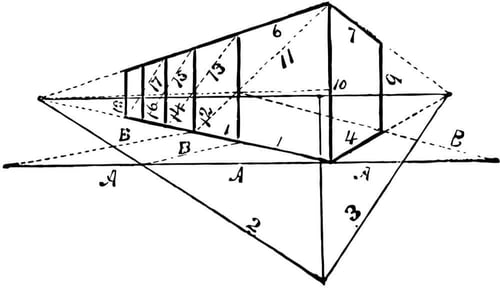Tl;dr - Our tools for knowledge management and ideation are constraining our thinking and success. That's true in business strategy, and it's particularly acute in the way it's impinging on marketing data operations.
Trapped in 2D
If you're active in the digital marketing community then you probably have your own swipe file, and vicariously benefit from others. Heck, if you're a sentient person consuming masses of content, you have some sort of a swipe file these days.
I always enjoy seeing what Tamsen Webster selects from her swipe file to include in her helpful Thursday emails.
The premise is simple. We see so much every day. Lot's of it is inane. Some of it is pithy. A small amount of it really resonates and spurs thoughts of our own. We need to somehow preserve that. But it can quickly become overwhelming because absent a framework, it's unwieldy.
Dave Gerhardt recently announced in his Facebook marketing group that he's basically had to abandon/reboot and has started a new one using Trello.
The problem with a swipe file is the many faceted challenge of knowledge management.
It's easy to collect things. It's hard to catalog them in a dynamic way to capture relationships and connections between ideas. And it's virtually impossible to ensure that the relevant ideas bubble up at the right time. You have to remember them, search for them, and hopefully find them.
That's the limitation of two dimensional systems like Trello, Evernote, Workflowy or other tools.
Anyone can build a literal or virtual file cabinet full of stuff. That's a resource library.
What creative knowledge workers need is a sentient knowledge base. A swipe file (specific examples and ideas) would then nestle amongst research notes, life lessons, aspirations, goals, ideas from other disciplines, reading insights and educational gems to create a neural network to surface interesting intersections of ideas.
Then the swipe file would become one element of an access on demand knowledge base - maybe we could call it your knowledge stack - and far more valuable.
When We Really Need 4D

Sounds kind of like science fiction, right?
You may be thinking "For now I'm thrilled to have my swipe file - be it magazine tear-outs in a folder, bookmarked links, notes in a google doc, or whatever."
Fair enough, but it's not going to work. You know the stats. 90% of the world's data has been created in the last two years alone.
So to assimilate, organize, curate and use all the relevant information on demand will be a monumental task.
That will take a 3D approach to your knowledge stack to organize things in relation to each-other.
That will be a vast improvement, but still not enough.
Let's use a 4D analogy. What if the information was constantly reindexed in the context of all new information - rather than a static classification, rather a dynamic reorganization.
"But that's what AI is going to do" you might be saying.
And you might be right. But that's not happened yet, and in the last two years we've nearly drowned.
What's worse, is that as we've nearly drowned (and treaded water trying to stay afloat in the sea of data) we've missed critical opportunities to change ourselves, our companies, and our communities. We're missing opportunities that lie at the intersection of disparate data that we simply can't catalog and process. And our performance is impaired because we're squandering cognitive bandwidth trying to remember.
That's why I'm so excited about the dive I'm taking into Roam Research. I sense that it offers a potential solution that's been so elusive to this point. Roam's bi-directional linking, atomic block reference structure, organic data graph and other features seem to have the potential to wrangle knowledge as individuals in ways we've assumed were impossible.
Knowledge Stack and Data Stack
That leads us to an interesting point. An example of the challenge and an illustration of the opportunity.
The biggest challenge we face as a contact level™ purchase intent data provider is to help clients implement the data and build the appropriate marketing, sales and customer success motions. Implementation can be simple and linear, or complex and extensive.
With each client we work to find the right approach.
And in every case we're acutely aware that if there were better ways to integrate their entire data stack (first party, 2nd & third party intent data, enrichment data, and technographics) we'd be able to help them achieve far more.
That integration is neither simple nor easy.
And it's remarkably analogous to the challenge each of us faces with our knowledge stack. It's possible to collect it all in different tagged folders, but the cumulative value is vastly less than the sum of an integrated whole.
At the same time, the thinking and development work I've been doing around personal knowledge management, and my immersion into the Roam community ( @RoamResearch #RoamCult), is similar to the journey we've been on to help companies fully integrate, activate and orchestrate their full customer and marketing data stack
And the solution that's required is also similar.
It's possible to put pieces of data into a swipe file to view them in a static way (often what happens when data is integrated with CRM.) You have to know what's there and be disciplined to look for it each time - and hope that it's close enough in relevance to be additive to your sales effort.
In your swipe file, you might rely on tags to try to create enough 3D structure to stimulate recall or recognition at the right moments.
Looking at marketing data, a 3D approach might notify you when there are concurrent third-party buyer intent data signals for an individual who has also visited your site, submitted a form, and/or opened/clicked emails.
Just as Roam seems to promise to create what is essentially an external neural network of your thinking and knowledge, unlocking the full power of marketing data requires a system which unifies and leverages the entire data stack.
That's the promise of truly unified data. Activation becomes natural as orchestration becomes robust.
Demandbase One is a really exciting advance toward that objective. Their launch last week was well executed and their vision is solid. They've certainly set a bar for all of us in the industry.
A Networked Knowledge Management Experiment
The more I dive into the parallels between individual/corporate knowledge management and strategy, and full marketing data stack orchestration, the more intrigued I am.
I'm considering creating a shared knowledge graph around marketing data. Think of a slack workspace, but building networked cognition versus message exchange.
Any interest in participating?




